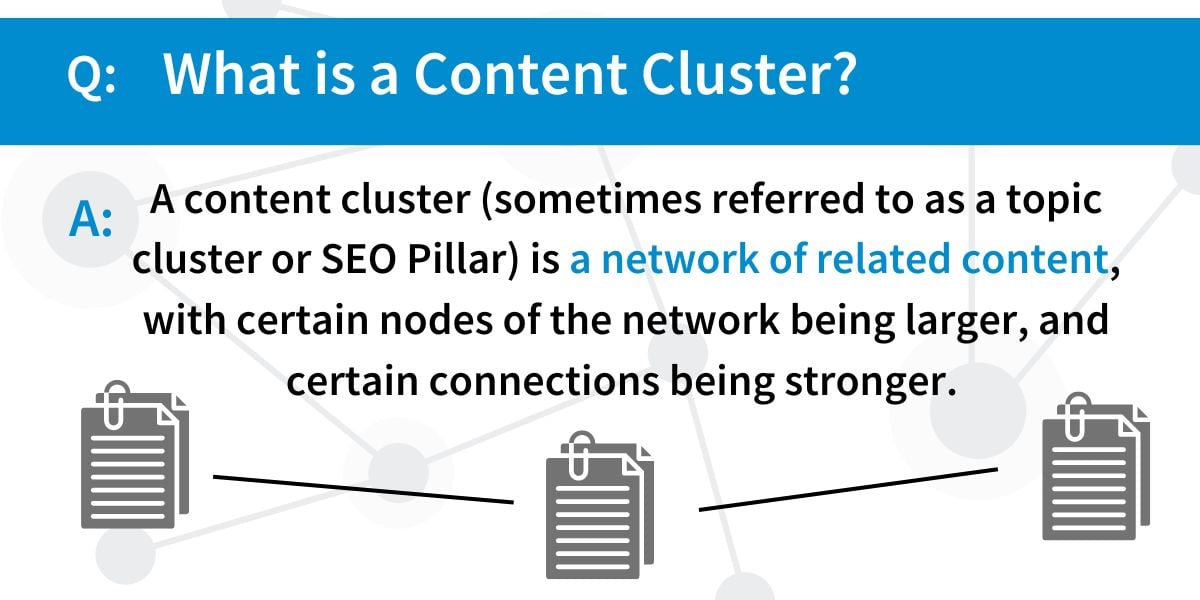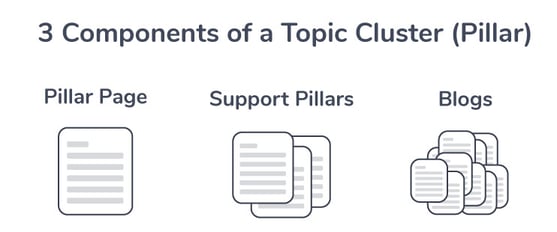What is a Content Cluster?
February 18, 2022 •Andrew Gold

You are probably familiar with the phrase, “content is king.” Whether you are a digital marketer or a YouTube influencer, producing content is the name of the game. But, if you really want to be successful, you need to do more than just create content for the sake of content. You need to create in an intentional and deliberate way.
For example, if you want to reach the first page of Google, you can’t just randomly generate content and hope it sticks. Even if you conduct extensive SEO keyword research and pepper the correct phrases all throughout your work, content that stands alone cannot rank successfully. So, how do you go about creating intentional content that works together? By using content clusters - aka"topic cluster" or "SEO Pillar."
What Are Content Clusters?
A content cluster (sometimes referred to as a topic cluster or SEO Pillar) is a network of related content, with certain nodes of the network being larger and certain connections being stronger. Essentially, a content cluster is based on the idea that anyone who is searching for a phrase on Google is also likely to search for similar phrases within the same topic.
Think about it like this: if you searched “Covid PCR test” on Google, in addition to search results, you will likely see “common questions.” These common questions include things like “How accurate are PCR tests?” or “What are the different types of Covid test?” Along with your original search, these questions form part of a content cluster.
Content clusters look to answer every question, big or small, that your audience is searching for. With clusters, you better understand how the reader is thinking and what things they are asking on a consistent basis. With this knowledge, you can take the guesswork out of marketing your content by tailoring it to the psychology of your audience.

One type of content cluster is the pillar model. Let’s discuss that next.
What is an Example of a Content Cluster?
Let's say you’re creating content for your B2B (business-to-business) company, which is a comprehensive marketing platform. Your internal marketing team has decided to create a content cluster around the topic of "lead generation." The core piece, or SEO Pillar, is going to be an in-depth guide called "From Cold Calls to Hot Leads: The Ultimate Guide to B2B Lead Generation."After you’ve written this Pillar piece, you write several supporting pieces, including:
- “10 Strategies for Generating More B2B Leads”
- “B2B Lead Generation: Benefits and Best Practices”
- “What Is Lead Generation?”
- “How Do You Use Social Media for B2B Lead Generation?”
For a more detailed guide on content clusters, consider following Pillar-Based Marketing (PBM) best practices, which we’ll take a look at in the next section.
One type of content cluster is the pillar model. Let’s discuss that next.
What Is a Pillar and Content Cluster?
A Pillar is one type of content cluster that we employ and recommend here at DemandJump as part of a larger PBM strategy. This strategy outlines a way of structuring content to not only rank well within Google but also to provide comprehensive and easily accessible content on any given topic. A Pillar refers to the entire topic of content, including all three specific subsections. Let’s break them down.
What Are the Main Components of a Topic Cluster or Pillar?

When it comes to creating topic clusters with PBM, there are typically three tiers of content:
- Pillar Page
- Support Pillars
- Blogs
Pillar Page
The Pillar page is roughly 3,000 words about the largest node in the topic cluster. So let’s say your cluster is about 5-gallon buckets. Your largest overarching node in the network of related searches is the term “5-gallon bucket.”
This is what your Pillar will be. With the help of keyword research and your content cluster, this Pillar page will cover basically everything mentioned in the entire network of searches. So back to our buckets, let’s say other smaller nodes in the cluster are “What is a 5 Gallon Bucket”, “Types of 5 Gallon Buckets,” and “5 Gallon Buckets Near Me.” Within the Pillar, you will cover all of these topics and more to really answer the majority of searches around your Pillar.
Sub-Pillar
Sub-Pillars are the second tier of content (like the queries we mentioned above), and are typically 2,000 words long. These pieces should cover the next highest ranking searches after your Pillar. In our bucket example, one might be “Types of 5 Gallon Buckets.” Once you identify your Sub-Pillar, you should write about any topic that falls under it within the topic cluster.
An important part of your topic cluster content strategy is to link your Sub-Pillar back to your Pillar. This helps inform Google and readers that your content is more trustworthy and works together to answer a wide range of questions about this Pillar.
Supporting Blogs
At 750-1000 words, Supporting Blogs answer the smaller, more narrow, questions readers are searching for. For example, within the types of 5-gallon buckets topic, people might ask about food-grade plastics or types of lids for 5-gallon buckets.
Blogs are the pieces that answer these subtopics within the Pillar and Sub-Pillar. Again, to improve your content’s overall ranking, Supporting Blogs should link back to the Pillar and Sub-Pillars they are relevant to.
DemandJump's podcast, Page One or Bust!, often discusses PBM best practices. In the clip below, our writers discuss how they typically go about creating a content cluster. For the full episode, follow this link.
How Do I Create a Content Cluster? Use DemandJump
At DemandJump, we know the world of SEO is ridiculously competitive. That’s why we created the tools to power the world’s content. Without our tools, you can take the guesswork out of marketing by:
- Creating content clusters around topics your readers care about
- Generating keyword outlines to power your content
- Developing Pillar strategies to outrank your competitors
So, if you’re ready to finally see your content at the top of Google rankings, get started for free today!
Featured Articles
Categories
- Attribution Tracking (13)
- Channel Optimization (11)
- Consumer Insights (68)
- Content Marketing (251)
- Data Science (8)
- Digital Marketing (6)
- Digital Transformation (26)
- Enterprise (10)
- Lead Generation (14)
- Market Intelligence (8)
- Marketing Analytics (39)
- Marketing Attribution (57)
- Marketing Management (153)
- Marketing Operations (86)
- Organic Search (222)
- Paid Search (52)
- Pillar-Based Marketing (63)
- Programmatic Advertising (9)
- SaaS Content (14)
- SaaS Marketing (29)
- Search Marketing (111)
- SEO Keyword Research (28)
- SEO Pillar (18)
- SEO Strategy (46)
- SMB (5)
- Website Content (12)


